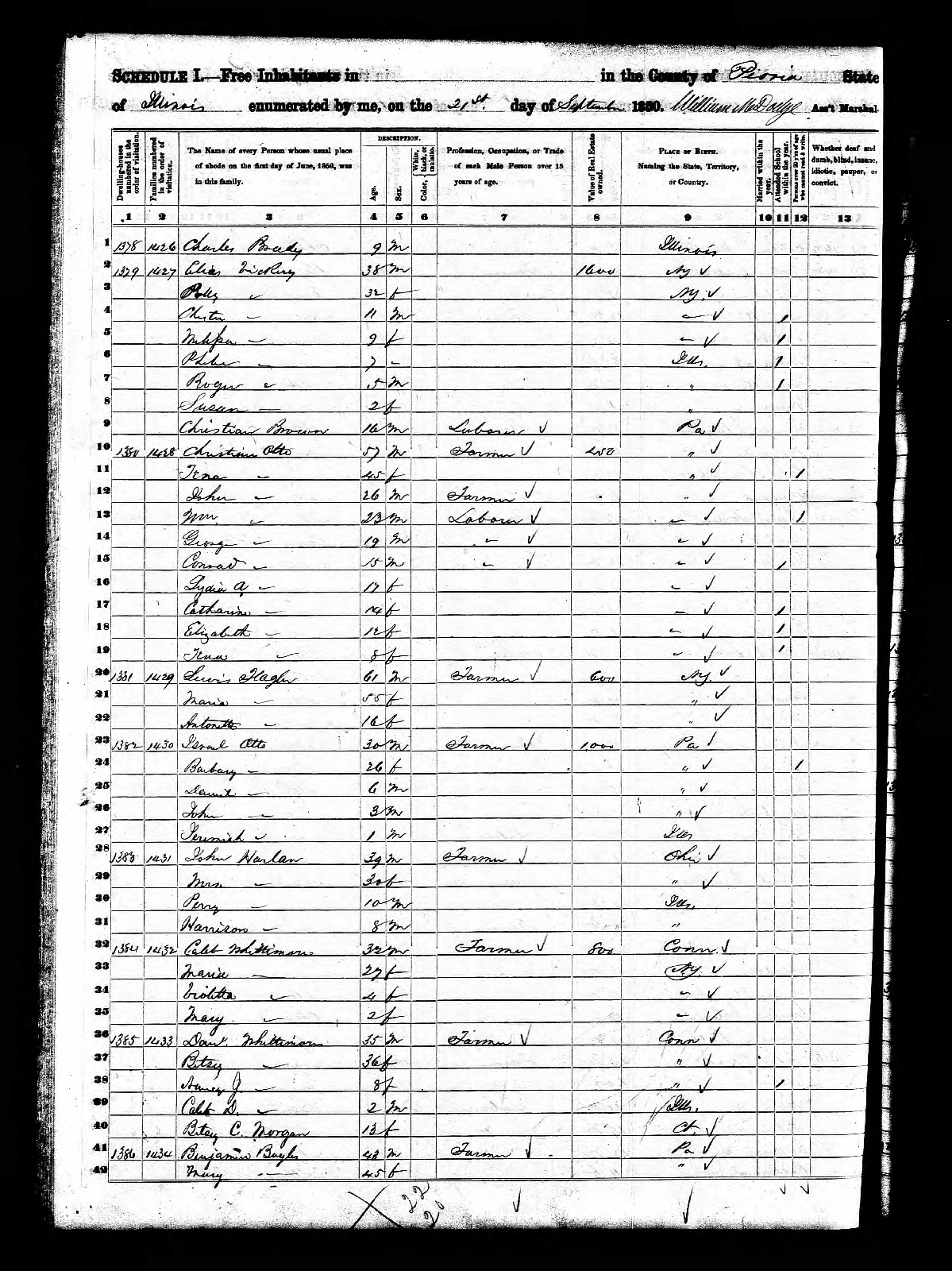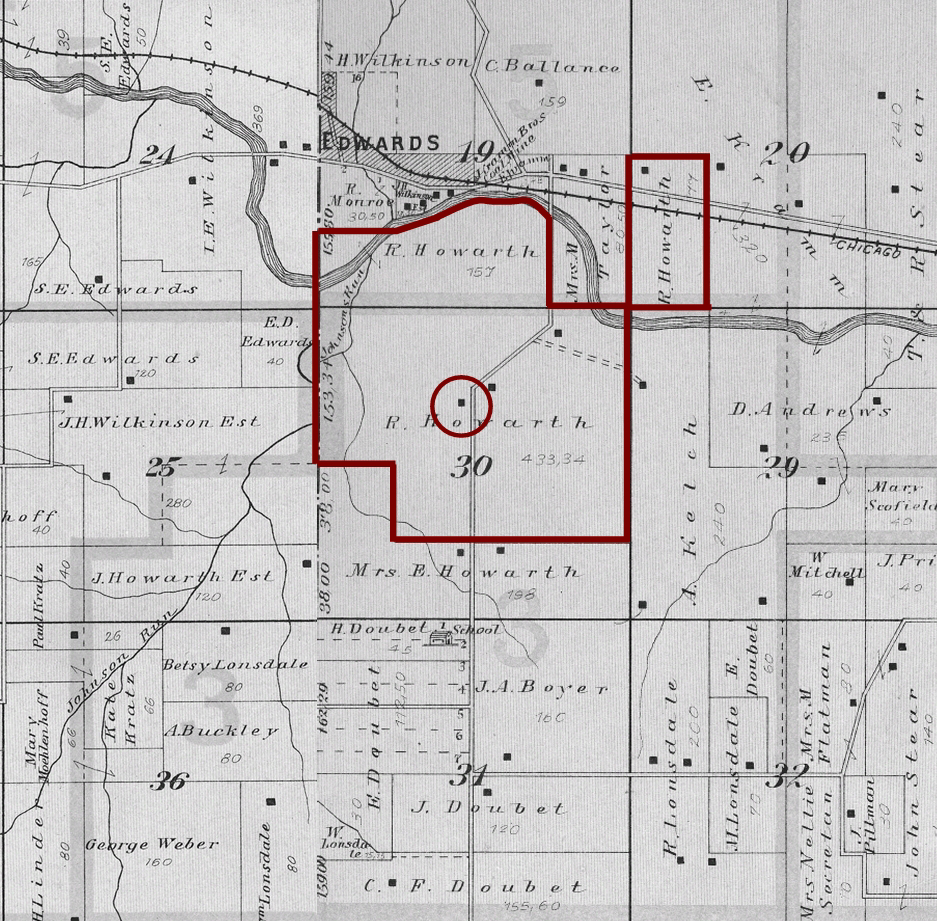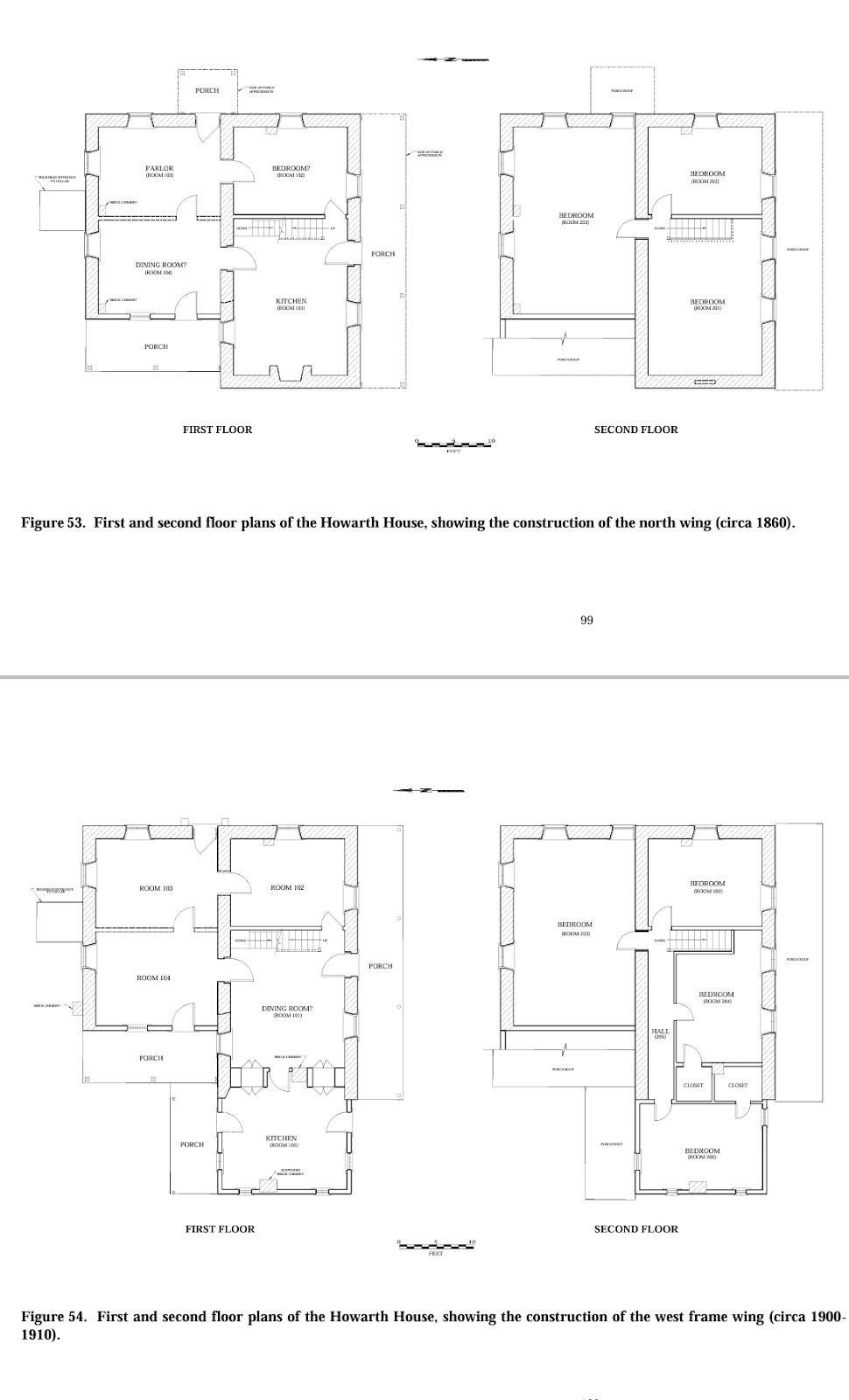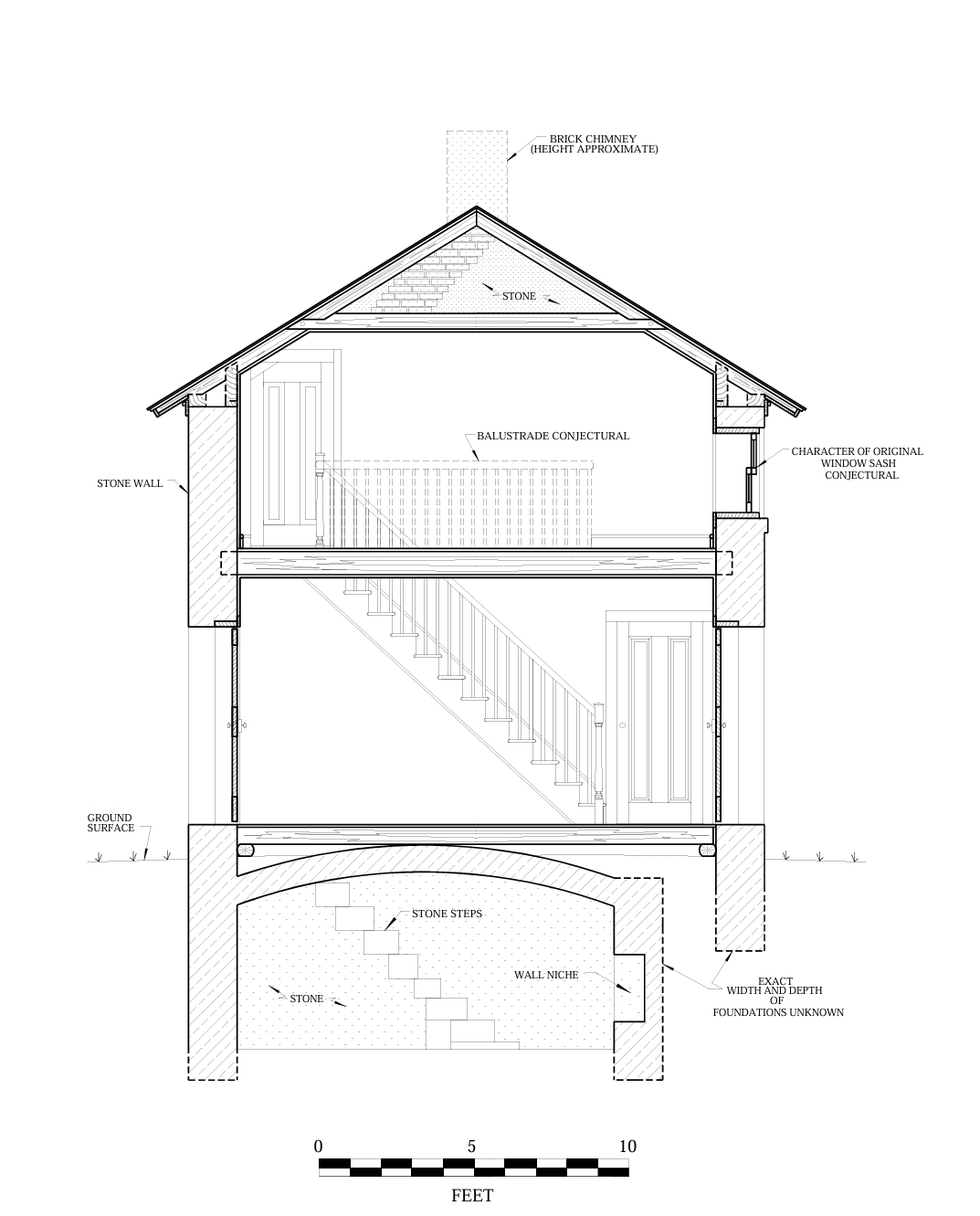1902 Kickapoo Township
Richard Howarth, one of the wealthiest residents of Kickapoo, resides on section 30, where he has a large and finely cultivated farm. Not only does the smiling prosperity everywhere visible over the broad extent of his domain bespeak his thrift, prudence, and intelligent adaption of means to secure the desired ends, but the substantial and tasteful buildings of stone which he has erected to accommodate his family and serve the needs of his stock, also proclaim in unmistakable terms that the owner has been no laggard in the "world's great field of battle." He is emphatically a self-made man, and an honor to the county of his adoption.
The parents of our subject, Richard and Martha (Greenwood) Howarth, were both natives of Lancashire, England, where they were married and lived until 1842. They then emigrated to America and settled in Kickapoo Township, in which place they resided until death claimed them for his own. Mr. Howarth was a stone-mason by trade, and followed the business while a resident of his native country, being engaged principally in contracting. After coming to America he commenced farming operations, but when a second harvest had been gathered he fell a victim to the Reaper Death, and passed peacefully away to his home on high, where life is one perpetual harvest of happiness. His wife lingered in this lower world some nine years longer, departing, in 1851, from its cares and pleasures, its sunshine and shadows. They were the parents of fifteen children, of whom the subject of this sketch was one of the younger members.
Richard Howarth, of whom we write, was born April 12, 1824, in Lancashire, England. He accompanied his parents to America in 1842, and remained under the parental roof until his marriage, in 1849, to Miss Alice Lonsdale. Their marriage was celebrated October 25, in Kickapoo Township, amid the festivities usual upon such occasions among the people of that day. With mingled sadness and joy the young couple bade farewell to their respective homes, and took up their abode on a piece of land which forms a portion of the present large farm of our subject.
Mrs. Howarth was a daughter of Thomas and Helen (Halsted) Lonsdale, natives of Lancashire, England. Mr. Lonsdale came to America in 1842, and was joined by his family the following year. They settled in Kickapoo Township, where they resided during the remainder of their earthly pil-primage. Mrs. Howarth was born in Lancashire, England, October 10, 1828, and entered upon the joys of the life beyond January 25, 1887. She was a member of the Presbyterian Church, and throughout her life was an affectionate daughter, a devoted wife and mother, and a true Christian whose death was a severe loss to the entire community, as well as a deep affliction to her immediate friends.
Mr. Howarth is the father of two children, the eldest of whom, Samuel, died when one year old. The second, Martha E., is the wife of William Taylor, and resides with our subject. Mr. and Mrs. Taylor are the parents of six children, as follows: Alice A., Susanna, Richard, Helen, Arthur and Mabel. Arthur departed this life when a tender infant of six months.
Our subject is the possessor of a large farm, comprising some nine hundred acres of land in Kickapoo Township, upon which he resides. He also owns valuable property in the city of Peoria.
Aside from his farming and other interests, he is largely engaged in the mining of coal at Edwards' Station in company with William and James Taylor, and is also engaged with Isaac Wantling in a separate coal mine. They have been very successful in this business, and are amassing wealth with gratifying rapidity. Our subject takes a lively interest in the welfare of his adopted country, and keeps himself abreast of the times by reading and meditating upon the great questions that are presented for consideration from time to time. In politics he is a Republican, and has the good will and admiration of his party friends, but does not make enemies among his political opponents, believing it the inalienable right of everyone to think for himself. [Portrait and biographical album of Peoria County, Illinois; Chicago: Biographical Pub. Co., 1890, pg 763 - Transcribed by: Candi Horton]
From the HISTORIC STRUCTURE REPORT HOWARTH HOUSE AND BARN WILDLIFE PRAIRIE STATE PARK, PEORIA COUNTY
The Howarth Farmstead was settled by Richard Howarth, Sr. in 1842 and remained under the ownership of his descendents for the next 143 years. The Howarths were one of number of families from Lancashire who settled in close proximity to one another in this area during the 1840s. During this period, Lancashire was the center of Britain’s textile industry and was home to the growing industrial cities of Liverpool and Manchester. Prior to immigrating to the United States, the Howarths had resided in the town of Bacup, which was located on the western slopes of the Pennine Mountains, in eastern Lancashire. Interestingly, there was no direct evidence of them having been engaged in agriculture in their homeland. Richard Howarth, Sr. was a stonemason by trade and had been engaged as a contractor, while his son, Richard, Jr. began his work career as a miner in Lancashire’s coal fields (Johnson and Company 1880:773; Biographical Publishing Company 1890:763). The Howarths’ apparent lack of prior farming experience was a characteristic shared by many of the English immigrants who took up farming in central Peoria County during the middle nineteenth century; a good number of these immigrant farmers had been coal miners in England, while others had been involved in the textile industry and other trades. The Howarth family sailed from Liverpool in February 1842 and finally arrived in Kickapoo Township in September of that year, having come to Illinois via New Orleans and St. Louis (Johnson and Company 1880:773). On July 18, 1842 Richard Howarth had purchased the NW1/4 of Section 30 in Kickapoo Township (Township 9 North, Range 7 East ) for $191.68 (State of Illinois 1984). This quarter section of land contained 153.34 acres and was located in the uplands bordering the Kickapoo Creek Valley. The family’s first home was a sod house, but this was only a temporary arrangement until a more substantial stone residence could be erected. It was during the construction of the stone house, in 1844, that the entire family was stricken with the so-called “Reaper Death,” a sickness that claimed the lives of Richard Howarth, Senior and his son Samuel (Johnson and Company 1880:773). Richard Howarth, Jr. completed the house and subsequently took over management of the farm. Born in Bacup, Lancashire on April 12, 1824, Richard Howarth, Jr. one of fifteen children ultimately born to Richard and Martha (Greenwood) Howarth (Biographical Publishing Company 1890: 763). In the sixty years that separated his father’s death from his own, the younger Richard steadily improved his farm and eventually became one of the wealthiest farmers in Kickapoo Township, owning some 900 acres land, as well as real estate in Peoria. In addition to farming, Howarth also was involved in the local coal industry in Kickapoo Township. He mined coal on his own land until 1867-1868, when he abandoned in the trade in order to devote his full attentions to his farm. In the 1876, however, he would reenter the industry and become a partner in several local mines (Johnson and Company 1880:773; Biographical Publishing Company 1890:764). This juggling of mining and agriculture was a common practice among English immigrants. In 1849, Howarth married Alice Lonsdale, who also was a Lancashire native. Alice’s father, Thomas Lonsdale, came to the United States in 1842. The following year, the rest of his family emigrated from England, and they made their home in Kickapoo Township. Richard and Alice Howarth had only two children: Samuel, who died when he was only one year old, and Martha Ellen, who was born in December of 1851 (Biographical Publishing Company 1890:763; USBC Population Schedule 1900:122A). Richard Howarth, Jr. is listed in the 1850 census of Peoria County as a 25-year old miner who had been born in England. Other inhabitants of the Howarth household in 1850 included Richard’s wife Alice (age 22), his 66-year old mother, and two other tenants. The tenants were David Bond, an 18-year old laborer, and Jacob Waalslen, a 25-year old miner. All of the members of the household were from England. No values of personal property were recorded in the 1850 census of Peoria County, but Howarth’s real estate value was recorded as $2,000, indicating that some improvements had been made to the land (USBC1850b:138). Even though Richard Howarth was reported as “miner” in the 1850 census he also was engaged in farming. His farm was listed in the 1850 United States Agricultural Census with a value of $2,000, while his farm implements and machinery listed as being worth $100. Only 50 of Howarth’s 200 acres were improved. The value of his livestock was $215, for he owned only four horses, three “milch” cows, two other cattle, and twelve pigs. He had produced 150 bushels of wheat, 500 bushels of Indian corn, and 200 bushels of oats (USBC 1850a: 267). Howarth significantly expanded his land holdings over the course of the next decade. On June 2, 1851, he purchased 160 acres in the SE ¼ of Section 30 from Alfred G. and Antoinette Curtenius, John and Elizabeth Griswold, and Matthew and Charlotte Griswold, all residents of Peoria County, for $550 (Peoria County Deed Record 2: 144). He purchased an additional 160 acres in the NE ¼ of Section 30, T9, R7W on May 16, 1855 from Eliza Eadon, Eliza Crawley, and Marianne Eadon, of Peoria County, for which he paid $1,800 (Peoria County Deed Record MA:635). In the 1860 census of Kickapoo Township, Peoria County, Richard Howarth was reported as a farmer, with real estate now valued at $11,200 and personal property worth $3,000. Since the last census was taken, his mother had passed away and his wife had given birth to Martha Ellen, who was born in Illinois, eight years before. The Howarths also had three farmhands and one servant residing with them, all from England (USBC 1860b:120). The Howarth residence and barn appear on the 1861 land ownership map of Peoria County. The map also indicates that Howarth owned the northern two-thirds of Section 30 by this date (Allen 1861). The 1860 agricultural schedule listed the cash value of Howarth’s farm as $6,000, the value of farm implements and machinery as $500, and 150 acres as improved. While Howarth owned several animals and grew different produce, his biggest crop was Indian corn, of which he produced 2,000 bushels. Other produce included rye, 160 bushels; oats, 300 bushels; wheat, 350 bushels; peas and beans, 300 bushels; buckwheat, 20 bushels; hay, 20 tons; Irish potatoes, 300 bushels; and grass seeds, 15 bushels. The total value of orchard produce was $20. For livestock, Howarth owned twenty heads of cattle, twelve pigs, nine horses, and eight “milch” cows. The value of livestock was listed as $1525; the value of animals slaughtered was $200 (USBC 1860a:1).
The 1870 population census shows that Howarth’s real estate property had increased in value over the preceding decade to $20,000, while his personal property had decreased to $2,000. His household in 1870 consisted of himself, his wife, and daughter, in addition to two farmhands and one “domestic.” In contrast to their hired help a decade before, the domestic and farmhands employed by the Howarths in 1870 had all been born in Illinois (USBC 1870b:15). The agricultural schedule of 1870 indicates that Richard Howarth’s real estate had expanded to include to 300 acres of improved land and 300 acres of woodland. Despite the increase in tillable acreage, the schedule reports a decrease in the amount of produce Howarth turned out. He had more livestock than in 1860, although it was less valuable at only $1,220. He also had slaughtered $1,000 worth of livestock, substantially more than what was recorded in the 1860 schedule. The estimated value of Howarth’s farm production was $2,000 (USBC 1870a:3). On February 24, 1872, Richard Howarth purchased the N1/2, SE1/4 of Section 30 from his neighbor, James Greenough. That same day, Greenough purchased the S1/2, SE1/4 of Section 30 from Howarth. The Greenoughs later sold that parcel of land to Jonathon Howarth, Richard’s brother (Peoria County Deed Book ZD:11). An 1873 atlas of Peoria County includes a map of Kickapoo Township, which illustrates Richard Howarth’s own residence and three other houses (presumably tenant-occupied) on his land holdings. An orchard is depicted lying south of the Howarth House. The map suggests that Howarth had improved a large portion of the 300 acres that were recorded as woodland in 1870. Coal measures are shown on his land, as well as adjacent properties to the south and west of his. The 1873 atlas also includes a lithograph of the Howarth’s Farmstead, which illustrates the residence there and impressive stone barn (Andreas 1873:128, 135137). On April 12, 1876 Martha Howarth married William Taylor, who had emigrated from England only three years before (Bateman and Selby 1902:728). Rather than establishing a separate household, the couple lived at the Howarth Farmstead with Martha’s parents. The 1880 census lists William and Martha Taylor (ages 24 and 28, respectively) residing with Richard and Alice Howarth, along with their two young daughters, Alice (age 3) and Susanna (age 3 mo.). Other occupants of the Howarth household at this time included a domestic servant, from Virginia, and two farm hands, from England and Kentucky (USBC 1880b:27). The value of Howarth’s farm, including land, fences, and buildings, was reported in the 1880 agricultural schedule as $18,000. Only two other farms in Kickapoo Township were valued higher than Howarth’s, and two others had an equal value to his. Howarth, however, actually owned more land than any other farmer in the township (Agricultural Schedule 1880: 117). At this time, 500 acres of his land were improved, while the remaining 100 acres were woodland and forest. His farming implements and machinery were valued at $300, and his livestock was worth $3350. The estimated value for all farm products for the past year was $2,000. Howarth had increased his livestock holdings considerably since 1870. He now owned 100 head of cattle and 7 “milch” cows, 110 swine, and 70 poultry (presumably chickens). His cattle and swine were the largest herds in the township. Indian corn was the principal crop grown on the farm, with 4,000 bushels produced on 100 acres. Oats, rye, potatoes, and apples also were grown (USBC 1880a: 14).
In addition to farming, Richard Howarth also mined coal on his land. The extent of his early mining operations are not known, since he is not listed as a coal operator in either the 1850 or 1860 Industrial Schedules of Peoria County. Yet, he reported his occupation as “miner” in 1850, at the very time that the first extensive coal operations in the county were starting up in around Hale’s Mill (later Pottstown). He possibly worked the coal measures the 1873 atlas of Peoria County illustrates on his land on the NE¼ of Section 30, south of Kickapoo Creek (Andreas 1873:127). Howarth retired from mining in 1867-1868, but he reentered the field in 1876, in partnership with William Taylor, his son-inlaw. Taylor, like Howarth, was a native of Lancashire, and one wonders if he too might have worked in the coal fields of that region prior to emigrating in 1873 (Johnson and Company 1880:773; Biographical Publishing Company 1890:764; Bateman and Selby 728). In 1882 Richard Howarth also established a coal-mining partnership with Isaac Wantling. Their copartnership agreement stated that the men intended to open a mine (or mines) on Howarth’s lands in Section 30 of Kickapoo Township. Howarth relinquished his coal rights on Section 30 to the partnership, and also agreed to give land in Section 19 for the construction of a grocery store, tenant house and other buildings that might be necessary for the operation of the mine. In consideration for providing the coal, the right-of-way, and the land to the business, Howarth was to receive six cents per each ton of coal mined, beginning after December 1, 1885. Profits above this royalty were to be shared equally, and the two men also agreed to split the costs of establishing and operating the mine. Another stipulation of the agreement allowed Howarth to substitute William Taylor for himself as partner in the firm (Peoria County Deed Record MG: 126-127). In a 1902 biography Taylor emphasizes his long-term involvement in mining coal on the Howarth Farm (Bateman and Selby 1902:728), and it is possible that he oversaw day-to-day operations of the mines, while his father-in-law devoted the bulk of his attentions to farming. The 1891 coal report for Peoria County lists seven mines operating at, or in the vicinity of Edwards Station, all of which were drift mines. The largest of these mines was operated by “Howarth and Taylor Brothers” (a firm comprised of Richard Howarth, William Taylor, and James Taylor), which employed thirty miners on average and had extracted 13,600 tons of coal for the year. This mine was one of two at Edwards Station that functioned as a shipping mine (presumably serving the Peoria market), and it was the only one that employed steam power; the other mines being either horse or hand powered. The coal report makes no mention of “Wantling and Howarth” (the name proposed in the co-partnership agreement) at Edwards Station (State Bureau of Labor Statistics 1891:120-121). An 1890 biography of Howarth, however, specifically states that he was “engaged with Isaac Wantling in a separate coal mine” (Biographical Publishing Company 1890:764). This suggests that the partnership between the men either had dissolved or was operating under a different title by this date.
In the 1900 census, Richard Howarth’s son-in-law, William Taylor, was listed as the head of the family household. Howarth himself was a widower by this date, his wife Alice having died in 1887. William and Martha Taylor’s six surviving children—Alice (age 22), Susannah (age 20), James (age 18), Ella (age 16), Mabel (age 10), and Walter (age 5)—were still residing at home in 1900. Despite his active involvement in coal mining, Taylor reported his occupation as “farmer” in the census. Richard Howarth was retired, but he retained ownership of the family farm; in the census, he was reported as a landowner, and Taylor as a renter (USBC 1900:122A; Biographical Publishing Company 1891:763-764). An 1896 plat map of Kickapoo Township illustrates the landholdings associated with Richard Howarth’s home farm during this period. Howarth also owned land on Sections 21 and 27, several miles to the east of his residence (George Ogle and Company 1896). His combined real estate holdings in Kickapoo Township during this period came to some 900 acres of land (Biographical Publishing Company 1890:764). A lithograph portrait of Howarth, was drawn late in his life. Richard Howarth died on February 3, 1904. In his Last Will and Testament, he left all of his real estate to his daughter Martha, except for those lands he previously had conveyed to her children (through deeds held in escrow). The will indicated that he deeded 240 acres to his oldest granddaughter, Alice Conley. The monies received by his heirs was as follows: Alice R. Conley, $1,000; Susannah Taylor, $7,900; Ella Taylor, $4,900; James Richard Taylor, $4,900; Martha Ellen Taylor, guardian of Mabel Ellen Taylor, $9,400; and Martha Ellen Taylor, guardian of Walter William Taylor, $16,400. Martha, acting as Walter’s guardian, was given the option of keeping his money in interest until he was of age or to use the money to purchase a farm for him at any time before he reaches a lawful age. Howarth also left $500 to the Episcopal Church of North Limestone (Christ Episcopal Church), of which he was a long-time member. He was buried in that church’s graveyard, next to his wife Alice, whose death had preceded his own by some twenty years. Howarth’s estate paid out a total of $45,359.91 to his debtors and heirs. No real estate or chattel was listed in the inventory of Howarth’s personal estate, due to the fact that he deeded all of his property to his daughter prior to his death (Peoria County Estate Record No. 6374). On July 15, 1903, Richard Howarth had deeded the following property in Kickapoo Township to his daughter: The NW¼ of Section 30, totaling 153 acres; NE¼ of Section 30; the NE¼, SW ¼ of Section 30; so much of the W½, SE¼ and the E½, SW¼of Section 19, as lies south of the center line of the main track of the Chicago, Burlington, and Quincy Railway; and the S½, SW¼ of Section 19, containing 160.46 acres. He also deeded her Lot 11 of Adam’s Addition to the City of Peoria, and Lots 3 and 4 in Kellog Place (laid out in part on Lot 4 and in part of the reservation in Ashael Hale’s Addition to the City of Peoria). The transaction was not recorded until February 8, 1904, four days after Richard’s death (Peoria County Deed Record VI:490, roll D-192). Martha Ellen Taylor is designated as the owner of the Howarth Farmstead on a 1904 Peoria County map (Hendrickson and Richardson 1904). Martha and William Taylor continued to reside in the Howarth House after her father’s death, and the couple is believed to be responsible for the construction of the circa 1910 wing on the west end of the dwelling.
Sources:
https://genealogytrails.com/ill/peoria/bio/biosH2.html
https://archive.org/details/portraitbiographi00biog/page/763/mode/1up
https://libcat.familysearch.org/Record/2306207?searchId=462923&recordIndex=4&page=1&referred=resultIndex
https://www.familysearch.org/library/books/records/item/507861-standard-atlas-of-peoria-city-and-county-illinois-including-a-plat-book-of-the-villages-cities-and-townships-of-the-county
http://illinoisarchaeology.com/IDNR/Wildlife
https://www.findagrave.com/memorial/85987346/richard-howarth












































